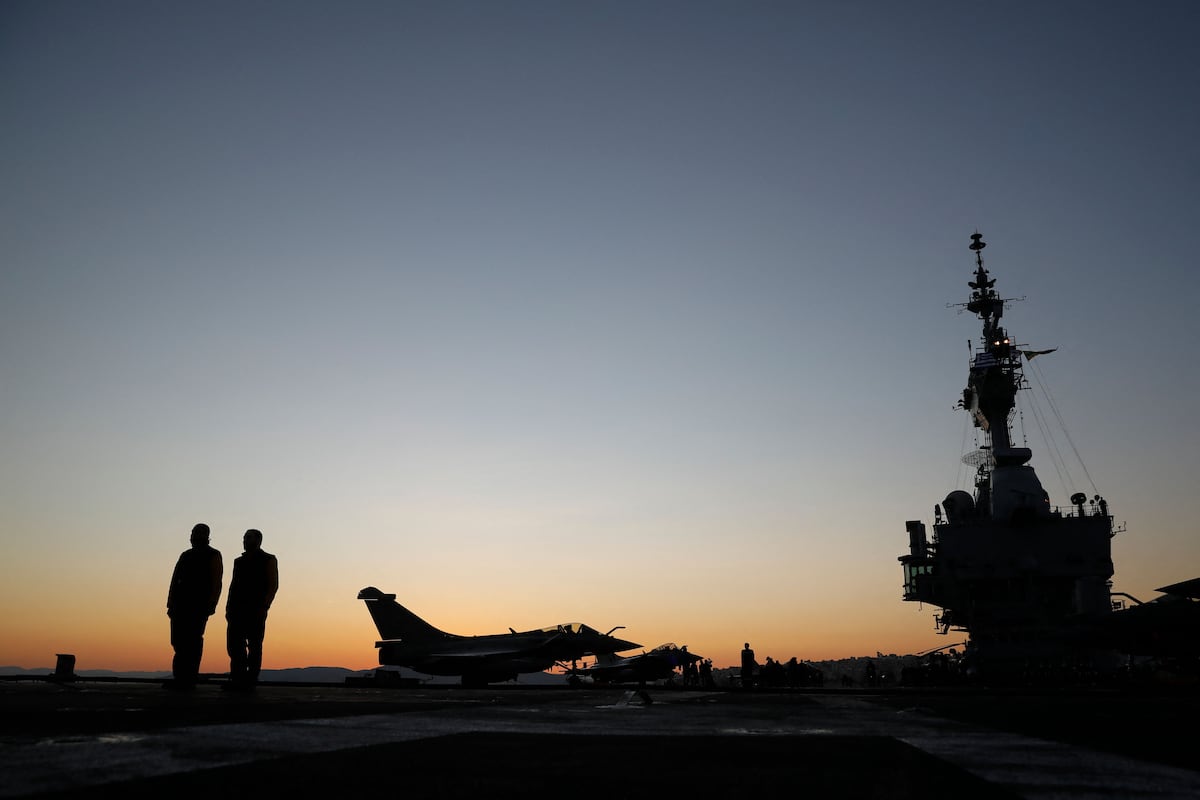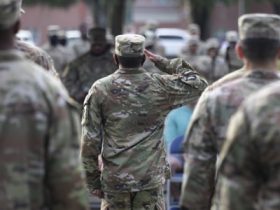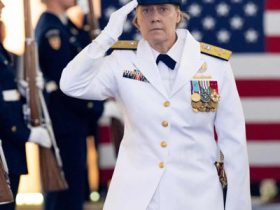Rear Adm. Jacques Mallard has led the French carrier strike group (FRSTRIKEFOR) since August 2023, focusing his efforts on enhancing how the naval formation shares information and trains in realistic battle conditions.
France’s nuclear-powered aircraft carrier Charles de Gaulle and its strike group are set to deploy over the next few weeks to the Indo-Pacific as part of mission Clemenceau 25, during which it will also take part in three major exercises with allies.
In an interview during the Euronaval Talks, organized in the context of the Euronaval show in Paris earlier this month, Mallard commented on the new types of environments and competitors the strike group is up against, the complexities of applying lessons learned after missions, and feedback from a recent exercise with the Italian Navy.
This interview was edited for length and clarity.
Data has been at the center of all discussions this week given the unprecedented level of information military forces are now faced with and the importance of having capable systems to verify, simplify and transmit this data faster than humans can in many cases. How does FRSTRIKEFOR ensure this?
The French Navy has developed data hubs that it has already tested on a ship [Fremm Provence] and we will be deploying several of those inside the FRSTRIKEFOR for the next mission sailing off at the end of the year to the Indo-Pacific.
We have had one issue inside the French Navy, where we don’t always have the competence to use data [as much as we should]. Data is what I call a work of art, you must know how to make sense of it in order to improve decision-making. That is why data scientists from industry on military reservists contracts will also be onboard our next mission to assist us with their competence in data analysis and interpretation. We expect that through this experimentation our ability to use it and develop some new applications can be applied across the entire French Navy. Once those applications are fit for operations, they could be used as a standard.
FRSTRIKEFOR often participates in international exercises with other allies, as was the case recently in Mare Aperto 2024, with the Italian Navy. What feedback did you take away from this and how do such events reinforce the battle group?
The Mare Aperto/Polaris [exercise] is basically changing the way we see training and the way we see war at sea, where you are opposed to another force that will not act as scheduled on the program. It gets two symmetric forces, one on each side, and assigns dedicated missions to either slow or hinder your opponent. It is essentially a confrontation of will, like real wars, and closer to what we can expect in the next couple of years concerning war at sea.
We have agreed with the Italian Navy to test this concept – Mare Aperto was an interesting challenge. We had 50 combat units in the West Mediterranean sharing the same tactical situations and positions.
One point that differed a little bit with the other editions of Mare Aperto was that when you were hit, you could not be revived. When you had fired all of your weapons, you had to reload, meaning you had to go into port … which required time to do. We trained in more realistic conditions.
The Italian Navy is a very very efficient one – with good ships, radars, submarines, and sensors, and being opposed to them with our carrier strike group was a very challenging experience. We had seven days of high-intensity training, both groups going up against each other. The general lessons learned were very positive. The commander of the Italian group told me that the training gained through Mare Aperto was a very, very interesting way of raising the stakes and allowed them to be more ready to be deployed in other regions.
How do you balance being transparent about operations and information with your allies while also keeping a certain level of confidentiality for opponents to not be able to predict your next move?
That is definitely a real challenge. Because on the one hand, you want to share – sharing means opening bridges, ways of exchanging information and sharing makes you very powerful. But on the other hand you want to protect yourself – you don’t want to have the opponent understand what your intentions are because that will give him the opportunity to have an advantage on you.
Until now, most of the communications infrastructure was segregated so we had a specific, secret network level where we would exchange data or tactical situations through data link. In my opinion, this was the early 21st century way of protecting things. Today, with getting new data management tools and raw material, we must think of a different way of sharing information and most importantly of protecting the data itself.
This is where a data-centric security approach comes into play – being able to send a pack of data to several different allies but [building and tailoring it] so that only specific allies have access to it and are reachable for the one that concerns them. For example, let’s say you have ten data sets to work and send to five different nations, one nation will have [access to] the whole ten but the other ones will only get eight.
What will the upcoming deployment of the FRSTRIKEFOR to the Indo-Pacific entail?
France has deployed ships to the Indo-Pacific previously, but it has been quite a few years since we deployed a high-end asset to the area. The general intention is to continue this momentum to show the interest of France in this particular part of the world, where at least 40% of the world’s GDP will transit through in the next decade. We have developed a fairly robust level of interoperability with fellow members of NATO, and the hope is to achieve a similar level of cooperation with Indo-Pacific navies.
The purpose of our deployment will be to raise up the expectations in order to make sure we’re not just talking to each other on a radio, [but] that we can actually conduct operations together. A key element to increasing interoperability is sharing data with fellow partners, and making sense of all the information the carrier strike group is gathering is a major focus of this upcoming mission. When you have at least seven to ten ships and aircraft gathering data simultaneously across many domains, there’s a fairly huge amount to collect.
There are many nations to collaborate with in the Indo-Pacific, and it’s a very important challenge to raise the stakes and catch up with the way they’re doing things. That is basically what I am working on and it will be a fairly long process. Then, after that, we will go through the lessons learned and maybe change some of our processes and standards or weapon systems and sensors in order to always follow up with what will be the next threat.
To absorb lessons learned, are we talking about a matter of months or years to change or adapt strategies? How does that work?
I wish it could be a matter of days or weeks – but it’s mostly months and years. The thing is that we have very, very complex weapon systems, when you think about the Rafale, the French carrier strike group has a number of them, so to make them evolve, is not as easy as an Iphone. You know sometimes we would like to be as agile and as able as Google is, but we are not able to do that.
Another thing to consider is that the biggest challenge and strengths of our units is the men and women that are working together in order to use their weapons. It takes a long time to form an officer of the watch, a commanding officer but also an operator of a radar. So you cannot change every two weeks with a new version of the things you need to work on.
On the one hand, you need to be as close as you can be to the best tech availability, on the other hand we need to have people that know how to use it – that’s the biggest challenge of all the navies, to form the new operator of a new sensor that will completely change the way of doing war at sea.
But not everybody is a PhD in tech, and so we are building up the way we are teaching those competences and that’s something that takes time. You cannot make a mistake on that. If you are forming somebody that is not adapted to the new sensors that will be developed.
In my discussion with the French chief of staff of the Navy we touched on how emerging technologies like artificial intelligence may shape the future of naval operations. When it comes to the future of the Carrier Strike Group and the missions you will embark on, how might some of this emerging tech shape or change the way you operate?
Information is now a domain where you can fight each other through different ways of seeing things and that can also have an effect on public opinion. But showing or hiding information is also an issue. At sea, the only questions you ask every moment as a task force commander are: Who is where, and what are their intentions? Because we are on a moving vehicle and we are in a moving domain, and there is civilian transport going around as well as competitors.
The new data that you are talking about will enhance this priority of information – in thinking of quantum technology, in a couple of years, no code and no crypto will be resistant to this kind of power of computing. We have to think about how we will protect our information against this. Talking about AI – it will definitely enhance the awareness of sensors.
There is however one thing that will never change – that is that when you are at sea and preparing for combat, you have to be ready to concentrate your firepower and defend all your platforms. There is no AI that will give you this protection against the fire of an enemy. However, what AI can give you would be basically the challenge of what could be happening with a competitor, to get you more ready for different scenarios and not be taken by surprise.
How would you say international cooperation has evolved over the years and the amount of data you now have access to changed the operations the FRSTRIKEFOR carries out?
We’ve been through the sort of sleeping cycles of the late 1990s and early 2000s where no competitors were identified and we were mostly fighting against asymmetric threats. Over the last 3-5 years, everybody has realized that the threat we have to face and be prepared for is a symmetrical one, with missiles and with capabilities very close to us.
We are now cooperating at a sort of equal level with the threat – being a lot more humble and thinking more efficiently than what we were used to and [going away] from the sort of confidence that we were the best. Now, we are challenged.
In what way would you say you are the most challenged today compared to earlier years?
It is in basically every way. For now, the common spaces either cyber, maritime but also space, are basically an arena where the challenge is permanent. Everyday, you see in these domains, across the world, some powerful competitors trying to gain and appropriate themselves a piece of this common airspace.
As seamen, we are very attached to the freedom of navigation and the fact that high seas belong to everybody and that between seamen we have to be a sort of solidarity because living at sea is not living in the natural domain where men are used to. That is how the culture of our navy works. We do also see more and more fishing vessels as well as actors saying, “It is my place to interdict the freedom of the traffic in the Red Sea for instance or South China Sea.” And that is a big challenge for us.
We are not anymore free of our movements – we have to cope with the intentions of most people that want to change the rules of order that have governed the sea over for a long period of time. So, either we get in agreement or our toes will be stepped on.
What are your main ambitions for the FRSTRIKEFOR in the next year?
The [Indo-Pacific] mission we are about to embark on will last long and we will go very far, so that is my main concern at present. For instance, we will be so far from our bases that logistics will be a game-changer and could potentially even be a show-stopper. So building up the logistics maneuvers of the deployment will be a challenge in itself.
Second, our experimentation with data – I think we are going to definitely be changing the way we are using our combat systems. We need to have a more versatile way of using information and filtering it.
Elisabeth Gosselin-Malo is a Europe correspondent for Defense News. She covers a wide range of topics related to military procurement and international security, and specializes in reporting on the aviation sector. She is based in Milan, Italy.
Read the full article here








Leave a Reply